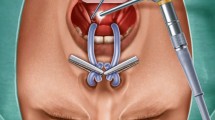Abstract
Pharyngeal orifice of the eustachian tube was ligated on ten patients, 15 ears with intractable patulous eustachian tube. While the eustachian tube orifice was observed by an endoscope inserted through the contralateral nostril, the orifice was ligated transnasally and/or transorally using instruments usually used in the endoscopic nasal surgery. Now 13–27 months after the surgery, the outcome was excellent (both symptoms and sonotubometry were normalized) in two ears, good (either symptoms or sonotubometry was improved) in seven ears, and unchanged in the remaining six ears. In one of the ears with an outcome of unchanged, the ligation was found to be spontaneously released soon after surgery, but the symptom was improved after the second operation 2.5 months after the first operation. Temporary otitis media with effusion was seen in one ear, mild inflammation around the ligated site also in one ear, but no other serious complication has been observed. Although further improvement in the surgical procedure and further discussion about its long-term outcome should be required, this procedure appeared to be one of the therapeutic options for intractable patulous eustachian tube.

Similar content being viewed by others
References
Bezold F, in Bezold F, Siebenmenn F (1908) Textbook of otology for physicians and students. Translated by J. Holinger. EH colegrove Co, Chicago, pp 154–155
Bluestone CD, Cantekin EI (1981) Management of the patulous eustachian tube. Laryngoscope 91:149–152
Bylander AKH, Ivarsson A, Tjernstrom O, Andreasson L (1984) Middle ear pressure variations during 24 hours in children. Ann Otol Rhinol Laryngol 94(Suppl 120):33–35
Cantekin EI, Doyle WJ, Phillips DC, Bluestone CD (1980) Gas absorption in the middle ear. Ann Otol Rhinol Laryngol 89(Suppl 68):71–75
Doherty JK, Slattery WH (2003) Autologous fat grafting for the refractory patulous eustachian tube. Otolaryngol Head Neck Surg 128:88–91
Hergils L, Magnuson B (1985) Morning pressure in the middle ear. Arch Otolaryngol 111:86–89
Kobayashi T, Yaginuma Y, Takahashi Y, Takasaka T (1996) Incidence of sniff-related cholesteatomas. Acta Otolaryngol 116:74–76
Magnuson B (1978) Tubal closing failure in retraction type cholesteatoma and adhesive middle ear lesions. Acta Otolaryngol 86:408–417
Ogawa S, Satoh I, Tanaka H (1976) Patulous eustachian tube; a new treatment with infusion of absorbable gelatin sponge solution. Arch Otolaryngol 102:276–280
Proud GO, Odoi H, Toledo PS (1971) Bullar pressure changes in eustachian tube dysfunction. Ann Otol Rhinol Laryngol 80:835–837
Pulec J, Simonton KM (1964) Abnormal patency of the eustachian tube; report on 41 cases. Laryngoscope 74:267–271
Pulec JL, Hahn FW Jr (1970) The abnormally patulous eustachian tube. Otolaryngol Clin North Am 3:131–140
Sato T, Kawase T, Yano H, Suetake M, Kobayashi T (2005) Trans-tympanic silicone plug insertion for chronic patulous Eustachian tube. Acta Otolaryngol 125:1158–1163
Senturia BH, Carr CD, Rosenblut B (1962) Middle ear effusions produced experimentally in dogs. III. Further studies concerning the pathogenesis of the effusions. Acta Otolaryngol 54:383–392
Shambaugh GE (1938) Continuously open eustachian tube. Arch Otolaryngol 27:420–425
Simonton KM (1957) Abnormal patency of the Eustachian tube; surgical treatment. Laryngoscope 67:342–359
Stroud MH, Spector GJ, Maisel RH (1974) Patulous Eustachian tube syndrome; preliminary report of the use of the tensor veli palatini transposition procedure. Arch Otolaryngol 99:419–421
Takahashi H, Fujita A, Lee SH, Honjo I (1990) Experimental conditions for the development of persistent otitis media with effusion. Eur Arch Otorhinolaryngol 247:89–92
Tos M, Wiederhold M, Larsen P (1984) Experimental long-term tubal occlusion in cats. A quantitative histopathological study. Acta Otolaryngol 97:580–592
Virtanen H, Palva T (1982) Surgical treatment of patulous eustachian tube. Arch Otolaryngol 108:735–739
Author information
Authors and Affiliations
Corresponding author
Rights and permissions
About this article
Cite this article
Takano, A., Takahashi, H., Hatachi, K. et al. Ligation of eustachian tube for intractable patulous eustachian tube: a preliminary report. Eur Arch Otorhinolaryngol 264, 353–357 (2007). https://doi.org/10.1007/s00405-006-0185-9
Received:
Accepted:
Published:
Issue Date:
DOI: https://doi.org/10.1007/s00405-006-0185-9




